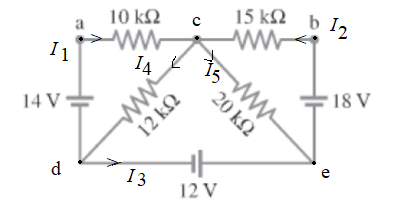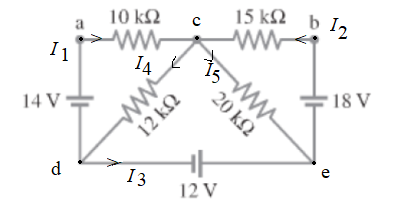
Concept explainers
(a)
The current flowing through the 14-volt battery.
(a)
Answer to Problem 79GP
The current flowing through the 14-volt battery us
Explanation of Solution
Given info:
Consider the given circuit.

Formula Used:
Apply Kirchhoff’s in the loop acd.
Apply Kirchhoff’s in the loop bce.
Apply Kirchhoff’s in the loop cde.
Apply Kirchhoff’s current law at node d.
Apply Kirchhoff’s current law at node e.
Calculation:
Substitute the values from equation (4) and (5) to equation (3).
Substitute the values from equation (5) to equation (2).
Substitute the values from equation (4) to equation (1).
On solving equation (6), (7) and (8),
Hence, the current flowing through the 14-volt battery us
Conclusion:
Therefore, the current flowing through the 14-volt battery us
(b)
The potential difference between point a and b.
(b)
Answer to Problem 79GP
The difference in the voltage is
Explanation of Solution
Given information:
Consider the given circuit.

Formula Used:
Let
Calculation:
The values of
Then, the value of
The difference between the voltage is calculated as,
Conclusion:
Therefore, the difference in the voltage is
Chapter 19 Solutions
Physics: Principles with Applications
Additional Science Textbook Solutions
College Physics
Applied Physics (11th Edition)
Cosmic Perspective Fundamentals
Conceptual Physical Science (6th Edition)
The Cosmic Perspective Fundamentals (2nd Edition)
University Physics (14th Edition)
 College PhysicsPhysicsISBN:9781305952300Author:Raymond A. Serway, Chris VuillePublisher:Cengage Learning
College PhysicsPhysicsISBN:9781305952300Author:Raymond A. Serway, Chris VuillePublisher:Cengage Learning University Physics (14th Edition)PhysicsISBN:9780133969290Author:Hugh D. Young, Roger A. FreedmanPublisher:PEARSON
University Physics (14th Edition)PhysicsISBN:9780133969290Author:Hugh D. Young, Roger A. FreedmanPublisher:PEARSON Introduction To Quantum MechanicsPhysicsISBN:9781107189638Author:Griffiths, David J., Schroeter, Darrell F.Publisher:Cambridge University Press
Introduction To Quantum MechanicsPhysicsISBN:9781107189638Author:Griffiths, David J., Schroeter, Darrell F.Publisher:Cambridge University Press Physics for Scientists and EngineersPhysicsISBN:9781337553278Author:Raymond A. Serway, John W. JewettPublisher:Cengage Learning
Physics for Scientists and EngineersPhysicsISBN:9781337553278Author:Raymond A. Serway, John W. JewettPublisher:Cengage Learning Lecture- Tutorials for Introductory AstronomyPhysicsISBN:9780321820464Author:Edward E. Prather, Tim P. Slater, Jeff P. Adams, Gina BrissendenPublisher:Addison-Wesley
Lecture- Tutorials for Introductory AstronomyPhysicsISBN:9780321820464Author:Edward E. Prather, Tim P. Slater, Jeff P. Adams, Gina BrissendenPublisher:Addison-Wesley College Physics: A Strategic Approach (4th Editio...PhysicsISBN:9780134609034Author:Randall D. Knight (Professor Emeritus), Brian Jones, Stuart FieldPublisher:PEARSON
College Physics: A Strategic Approach (4th Editio...PhysicsISBN:9780134609034Author:Randall D. Knight (Professor Emeritus), Brian Jones, Stuart FieldPublisher:PEARSON





